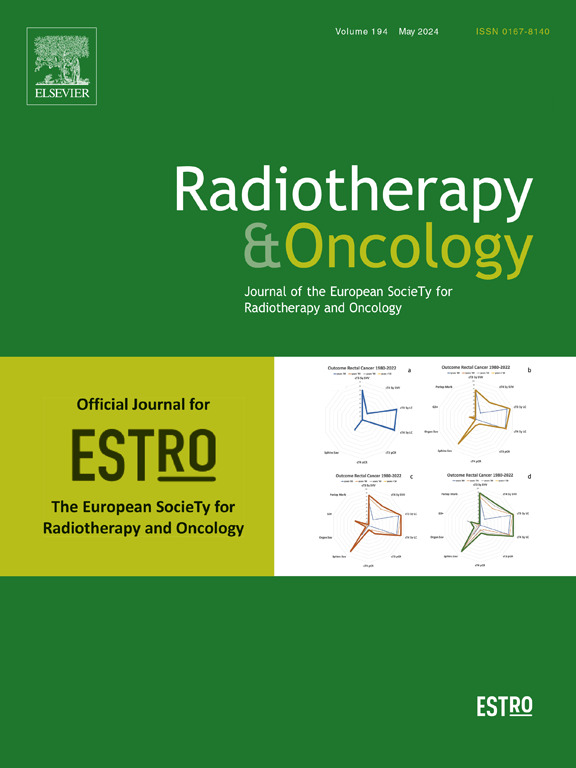低剂量率近距离治疗葡萄膜黑色素瘤视神经萎缩的剂量反应关系。
IF 4.9
1区 医学
Q1 ONCOLOGY
引用次数: 0
摘要
背景:在以往的研究中,近距离治疗葡萄膜后黑色素瘤后视神经病变和视神经萎缩的剂量-反应关系定义不清。在这里,我们分析了剂量学因素、涂抹器类型和肿瘤相关变量对结果差异的影响。目的:主要目的是评估近距离治疗葡萄膜后黑色素瘤后应用剂量与视神经萎缩的关系,以便对新患者进行风险评估。材料和方法:本回顾性研究是在一个单一的高容量眼科肿瘤中心进行的。我们纳入了视神经与最近肿瘤边缘最大距离为4个光盘直径的后葡萄膜黑色素瘤患者,患者接受了钌-106涂敷器近距离治疗并随访眼底照片。使用专用软件根据最近随访时眼底照片和施药器剂量分布重建视神经剂量分布。首先在眼底照片上叠加了视神经、黄斑、肿瘤和血管等重要结构元素,并使其与真实轮廓相适应。在第二步,涂抹器轮廓面具适应辐射疤痕,以计算剂量分布在所有结构。通过加权逻辑回归得到剂量-反应关系。结果:本组109例患者视盘最大剂量(ODmax)范围为5.8 Gy - 242.2 Gy,中位48.7 Gy。视神经萎缩29例。视神经萎缩的中位时间为18 个月。经加权logistic回归分析,视神经萎缩对ODmax的依赖性显著(p = 0.0001,chi2检验)。ODmax值有相当大的观察者间变异(p 2检验)。视神经萎缩的可能性的ODmax 50 % (ED50) 77.6 Gy ±7.0 Gy为患者切口穗轴涂抹器和53.2 Gy ±8.2 Gy患者其他涂抹器。包括施药器类型在内,具有ODmax的logistic模型的ROC曲线下面积达到0.857(95 %-CI: 0.793-0.921)。视神经病变的ED50,归类为 ≥ 1级毒性,视盘最大剂量估计为46.9 Gy ± 4.1 Gy。结论:低剂量率近距离治疗视神经萎缩具有显著的剂量-反应曲线。确定了COB涂抹器的标准位置,可以根据涂抹器的巩膜剂量估计剂量-反应关系,以便在没有眼底照片的情况下进行风险估计。这个更大的数据集增强了对视神经附近照射的剂量-反应关系的认识。本文章由计算机程序翻译,如有差异,请以英文原文为准。
Dose response relation for optic nerve atrophy at low-dose rate brachytherapy of uveal melanoma
Background
Dose-response relationships for optic neuropathy and optic nerve atrophy after brachytherapy for posterior uveal melanoma were poorly defined from previous studies. Here, the outcome differences were analyzed in dependence on dosimetric factors, the applicator type, and tumor dependent variables.
Purpose
Primary objective was to evaluate the association of applied dose and on-set of optic nerve atrophy after brachytherapy for posterior uveal melanoma in order to allow risk estimation for new patients.
Materials and methods
This retrospective study was performed at a single high volume centre for ocular oncology. Patients receiving brachytherapy with Ruthenium-106 applicators for posterior uveal melanoma with a maximum distance between optic nerve and the nearest tumor margin of 4 optical disc diameters and follow-up with fundus photographs were included. The dose distribution at the optic nerve was reconstructed from the fundus photographs at latest follow-up and the dose-distribution of the applicator using a dedicated software. A first mask with important structural elements such as optic nerve, macula, tumor and vessels was first superimposed on the fundus photograph and adapted to the real contours. In a second step, an applicator contour mask was adapted to the radiation scar in order to calculate the dose distribution in all structures. Dose-response relations were obtained by weighted logistic regression.
Results
The maximum dose at the optic disc (ODmax) in this group of 109 patients ranged from 5.8 Gy – 242.2 Gy, median 48.7 Gy. Optic nerve atrophy was observed in 29 patients. Median time to radiation induced optic nerve atrophy was 18 months. Using weighted logistic regression, the dependence of optic nerve atrophy on ODmax was significant (p = 0.0001, chi2-test). There was a considerable interobserver variability in ODmax values (p < 0.02, signed rank test). An additional factor influencing the dose–response was the applicator type (p = 0.0315, chi2-test). The ODmax for a probability of optic nerve atrophy of 50 % (ED50) were 77.6 Gy ± 7.0 Gy for patients treated with notched COB applicators and 53.2 Gy ± 8.2 Gy for patients with other applicators. Including the applicator type, the area under ROC curve reached a value of 0.857 (95 %-CI: 0.793–0.921) for the logistic model with ODmax. The ED50 for optic nerve neuropathy, classified as grade ≥ 1 toxicity, was estimated to be 46.9 Gy ± 4.1 Gy for the maximum dose at the optic disc.
Conclusions
Significant dose–response curves were found for optic nerve atrophy at low dose rate brachytherapy. A standard position of COB applicators was identified that allows estimation of the dose–response relation from the scleral dose of the applicator for risk estimation without fundus photographs. This larger data set enhances the knowledge of dose–response relationships for irradiation near the optic nerve.
求助全文
通过发布文献求助,成功后即可免费获取论文全文。
去求助
来源期刊

Radiotherapy and Oncology
医学-核医学
CiteScore
10.30
自引率
10.50%
发文量
2445
审稿时长
45 days
期刊介绍:
Radiotherapy and Oncology publishes papers describing original research as well as review articles. It covers areas of interest relating to radiation oncology. This includes: clinical radiotherapy, combined modality treatment, translational studies, epidemiological outcomes, imaging, dosimetry, and radiation therapy planning, experimental work in radiobiology, chemobiology, hyperthermia and tumour biology, as well as data science in radiation oncology and physics aspects relevant to oncology.Papers on more general aspects of interest to the radiation oncologist including chemotherapy, surgery and immunology are also published.
 求助内容:
求助内容: 应助结果提醒方式:
应助结果提醒方式:


